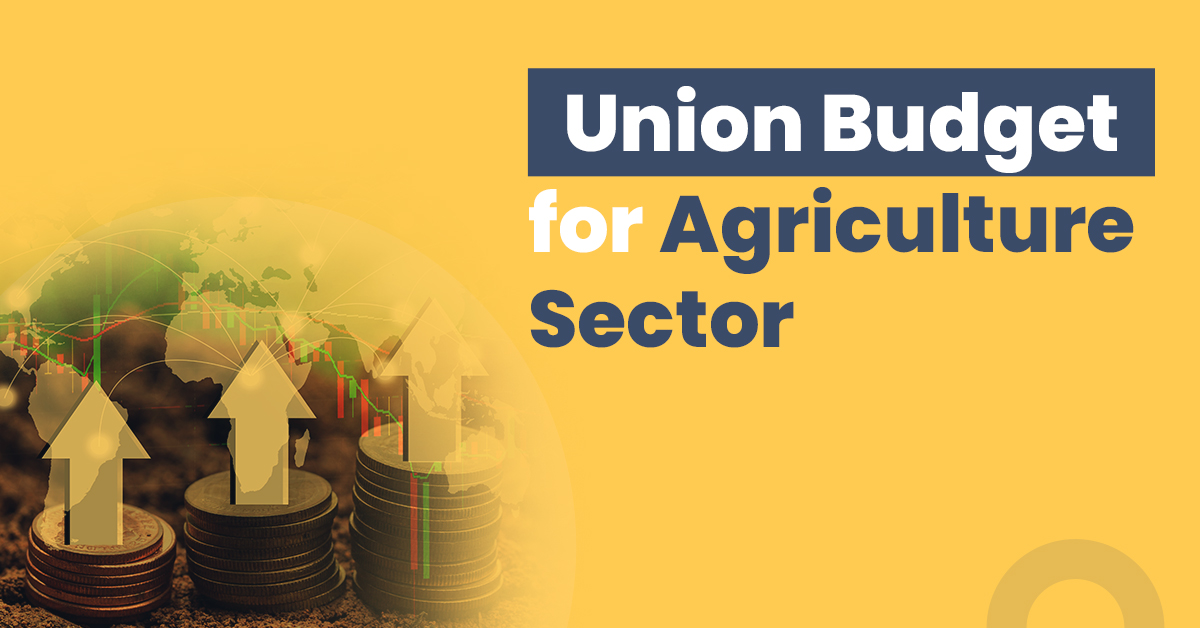Union Budget 2022-23 for Agriculture Sector in India


Union Budget 2022 probably could have shown a little bit more consideration in the allocation of funds towards the Union Ministry of Agriculture and Farmers Welfare. Instead, it has seen a meagre increase of 4.4% for the financial year. The aggregate allocation of ₹1,32,513 crore is slightly higher than the previous year’s budget of ₹1,26,807 crore.
However, the Government of India plans to double farmers’ income through a multi-faceted approach which will primarily focus on access to marketplace, finance, new age technology and organic farming.
Read on to know the key announcements in Union Budget 2022 with respect to the agricultural sector.
Agriculture Sector in India: An Overview
India’s agriculture sector is the largest industry which is responsible for the livelihood of 58% of our country’s population. As per the reports of Inc42, the Indian agricultural sector will supposedly grow by $24 billion by 2025.
This sector has seen good growth in the export sector in the Financial Year 2021-22. The export of marine products, sugar, rice, tea and coffee has brought a significant amount of profit. Some substantial schemes and developments have been scheduled by the Government to modernise the agricultural sector, reducing the gap between urban and rural markets.
Agriculture Sector in Union Budget 2022 – Key Announcements
The Government has allocated a budget of ₹6,75,000 crore for PM-KISAN Yojna, ₹7,183 crore for the Krishonnati Yojana, ₹15,500 crore for crop insurance scheme, ₹1,500 crore for Market Intervention Scheme and ₹10,433 crore for the Rashtriya Krishi Vikas Yojana (RKVY).
In addition to this, let’s take a quick glance at the key announcements in the Budget regarding agriculture sector:
Agriculture – Crops:
- In the first stage of implementation, the government will promote chemical-free organic farming across the country, focusing on the farming lands in the 5-km wide corridors along river Ganga.
- The government will actively try to reduce dependency on import of oil seeds by implementing a rationalised and comprehensive scheme to increase local production of oil seeds.
- With the participation of the state governments, farmers will be encouraged to adapt to suitable varieties of fruits and vegetables by using proper harvesting and farming techniques.
- The year 2023 has been announced as the year of millet production, and adequate support will be provided for post-harvest value addition, increased domestic consumption and branding and marketing of millet domestically and internationally.
- The estimated procurement of wheat in Rabi 2021-22 and of paddy in Kharif 2021-22 will approximately cover 1208 lakh metric tonnes of wheat and paddy from 163 lakh farmers. Also, the Government of India will make a direct payment of Rs. 2.37 lakh crore to farmers’ accounts.
- An estimated cost of ₹44,605 crore is allocated for implementation of the Ken-Betwa Link Project. It will primarily aim to irrigate 9.08 lakh hectares of farmers’ land and to provide drinking water supply, solar and hydropower.
Also Read: Union Budget For Auto Industry
Allied Agriculture:
- Reduced duty will be levied on some inputs of shrimp aquaculture.
- There has been a reduction in alternate minimum taxation from 18.50% to 15.00%. Additionally, surcharge has been decreased from 12% to 7% for citizens having an income between ₹1 crore and ₹10 crore.
- Financial support will be provided to farmers belonging to scheduled tribes and castes, along with changes in policies and legislation of agro and private forestry.
- As blending of fuel is a priority this year, unblended fuel will attract an additional excise duty of ₹2/Litre from October 01 2022.
Introduction of New Technology:
- With the aim to provide digital and hi-tech facilities and services to farmers, PPP mode will be launched with the involvement of private and public sector research and extensions of institutions.
- Launch and promotion of Kisan Drones will be encouraged to assess crops, spray insecticides and nutrients, and digitise land records.
- There will be enough support for digital involvement. Launching light-touch regulations, supportive policies, promotion of research and development, and facilitative actions to build domestic capacities will be done.
- There will also be provisions for the contribution of the government for R&D of sunrise opportunities such as drones, geospatial systems and artificial intelligence.
- A fund of blended capital collected under the co-investment model will be facilitated through NABARD. Its aim is to finance farm produce value chains and start-ups for agriculture and rural enterprises.
Logistics Development:
- Along with taking the lead in the integration of the postal and railways network, railways will develop new products and effective logistic services for small-town farmers and small & medium enterprises.
- There will be establishments of multimodal logistics parks at four selected locations and ‘One Station- One Product’.
Shortcomings of the Budget Regarding Agriculture Sector
The budget allocation for the agriculture sector has undoubtedly focused on some key factors, but here are some areas which might need more attention going forward:
- One of the primary goals of our honourable PM for this year’s budget was to double the farmer’s income. However, as per the National Sample Survey (NSS) Situation Assessment of Agricultural Households (SAS), the average monthly income of a farmer has increased by 59% over the past five years. To specify, their income has grown from ₹6426 to ₹10,218 since 2013, which doesn’t actually fit the framework of doubling a farmer’s income.
- Some schemes have given a significant hike in the allocation of funds, but for some, there has been a prominent slash of funds. For example, schemes such as National Project on Organic Farming, Paramparagat Krishi Vikas Yojana and the Green Revolution scheme did not receive any fund allocation.
- The National Rural Employment Guarantee Scheme (NREGA), one prominent scheme for providing employment in rural areas, faced a reduction of 25% in budget allocation.
- Budget allocation to FPOs has seen a reduction to ₹500 crore, which has yet to see any improvement in budget allocation in the last two years.
- As per the reports of the National Academy of Agricultural Sciences (NAAS), the over-emphasis on zero-budget natural farming can suggestively harm farmers’ income as well as long-term nutrition & food security of our country.
- Climate change has also impacted sustainable growth negatively. As a result, our agriculture sector needs more investments and attention to make it more climate-resilient.
Implications of the Budget Allocation for the Agriculture Sector
Here are some ways the Union Budget 2022-23 will affect the agriculture sector in India:
- Increased initiative to incorporate technology in agriculture has made access to credit easier to support evolution of value chains.
- More focus on value enhancement of horticulture products and low post-harvest losses
- Reduced input costs resulting in higher competition in the markets .
- Proper mix of cropping patterns and diversification of crops, which will lead to earning more revenues.
- Lowered dependency on traditional crops and more emphasis on the implementation of crop diversification will help India emerge as a world leader in the Nutri-cereals space.
- Possible hike in consumption of maze and rice in India in producing grain-based ethanol; this is an excellent opportunity for state government organisations who obtain grains to build grain-based ethanol production units.
- Higher profitability of the cooperative societies that are primarily related to rural and farming communities.
- Focus on environmental sustainability to become carbon neutral in addition to increased revenue to farmers in otherwise dryland areas.
- Lowered cost of input and production.
- Ability to retrieve more reliable data on production and efficiency of crop estimation with the help of remote sensing .
- Increased development of innovative technology-based solutions for the agriculture sector.
- Improved connectivity and popularisation of local business and supply chains.
- Logistical efficacy and optimisation of transportation costs.
- Logistical and transportation improvement to help small and marginal farmers to reach buyers in different states and long distances.
Final Words
The Union Budget 2022-23 has focused on the technology-based development of the agriculture sector; however, there could have been more emphasis on rural agricultural programs as well, which they deserve. Hopefully, the Government will reconsider the left-out issues in the next Union Budget.
Frequently Asked Questions
What is the Rashtriya Krishi Vikas Yojana (RKVY) scheme?
The Rashtriya Krishi Vikas Yojana (RKVY) was first introduced in 2007 and is a Central Government sponsored scheme. It focuses on the overall development of the agricultural industry and its allied sectors in India.
Why is 2023 announced as the International Year of Millets?
The Union Government has announced the year 2023 as the International Year of Millets as there will be more stress and support provided for marketing and branding of millet products nationally and internationally, which, in turn, will result in enhanced domestic consumption.
What are some agricultural schemes introduced by the Government?
The Union Government has launched multiple schemes and initiatives in the Union Budget 2022 to improve and develop the agricultural sector in India, such as Pradhan Mantri Kisan Maan Dhan Yojana (PM-KMY), Pradhan Mantri Kisan Samman Nidhi (PM-KISAN), Pradhan Mantri Annadata Aay Sanrakshan Abhiyan (PM-AASHA), Pradhan Mantri Fasal Bima Yojana (PMFBY), Kisan Credit Card (KCC), etc.



